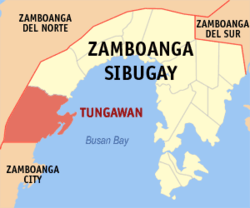Tungawan, Zamboanga Sibugay
| Tungawan | |
|---|---|
| Municipality | |
| Municipality of Tungawan | |
 Map of Zamboanga Sibugay with Tungawan highlighted | |
.svg.png) Tungawan Location within the Philippines | |
| Coordinates: 7°30′N 122°22′E / 7.5°N 122.37°ECoordinates: 7°30′N 122°22′E / 7.5°N 122.37°E | |
| Country |
|
| Region | Zamboanga Peninsula (Region IX) |
| Province | Zamboanga Sibugay |
| District | 2nd District |
| Founded | May 24, 1960 |
| Barangays | 25 (see Barangays) |
| Government [1] | |
| • Type | Sangguniang Bayan |
| • Mayor | Carlnan C. Climaco |
| • Electorate | 22,981 voters (2016) |
| Area [2] | |
| • Total | 473.28 km2 (182.73 sq mi) |
| Population (2015 census)[3] | |
| • Total | 42,030 |
| • Density | 89/km2 (230/sq mi) |
| Time zone | UTC+8 (PST) |
| ZIP code | 7018 |
| PSGC | 098316000 |
| IDD : area code | +63 (0)62 |
| Climate type | Tropical climate |
| Income class | 2nd municipal income class |
| Revenue (₱) | 144,121,238.02 (2016) |
| Native languages |
Subanon language Cebuano Chavacano Tagalog |
| Website |
www |
Tungawan, officially the Municipality of Tungawan, is a 2nd class municipality in the province of Zamboanga Sibugay, Philippines. According to the 2015 census, it has a population of 42,030 people.[3]
It has an area of 47,328 hectares (116,950 acres) of land, the largest in the province, as well as 15,236 hectares (37,650 acres) of coastal waters.
It was declared as a Municipality on May 24, 1959, and started functioning as an LGU on January 29, 1961, by virtue of Executive Order No. 395.[4] Its name was coined from the minute leech generally known as “tungaw” of the Hirudo family.
Tungawan's economy is primarily based on agriculture, producing rubber, coconut, corn, rice, and seaweeds. It is home to the 880 hectares Bangaan Marine Sanctuary at Barangays Linguisan and Tigbucay.
Barangays
Tungawan is politically subdivided into 25 barangays.
- Baluran
- Batungan
- Cayamcam
- Datu Tumanggong
- Gaycon
- Langon
- Libertad (Poblacion)
- Linguisan
- Little Margos
- Loboc
- Looc-labuan
- Lower Tungawan
- Malungon
- Masao
- San Isidro
- San Pedro
- San Vicente
- Santo Niño
- Sisay
- Taglibas
- Tigbanuang
- Tigbucay
- Tigpalay
- Timbabauan
- Upper Tungawan
Demographics
| Population census of Tungawan | ||
|---|---|---|
| Year | Pop. | ±% p.a. |
| 1970 | 11,838 | — |
| 1975 | 9,573 | −4.17% |
| 1980 | 10,679 | +2.21% |
| 1990 | 26,005 | +9.31% |
| 1995 | 28,552 | +1.77% |
| 2000 | 33,194 | +3.28% |
| 2007 | 37,588 | +1.73% |
| 2010 | 40,552 | +2.80% |
| 2015 | 42,030 | +0.68% |
| Source: Philippine Statistics Authority[3][5][6][7] | ||
References
- ↑ "Municipality". Quezon City, Philippines: Department of the Interior and Local Government. Retrieved 31 May 2013.
- ↑ "Province: Zamboanga Sibugay". PSGC Interactive. Quezon City, Philippines: Philippine Statistics Authority. Retrieved 12 November 2016.
- 1 2 3 Census of Population (2015). "Region IX (Zamboanga Peninsula)". Total Population by Province, City, Municipality and Barangay. PSA. Retrieved 20 June 2016.
- ↑ "Executive Order No. 395: Creating the Municipalities of Tungawan and Titay in the Province of Zamboanga Del Sur". Official Gazette of the Republic of the Philippines. Presidential Communications Development and Strategic Planning Office. May 24, 1959. Retrieved 6 August 2014.
- ↑ Census of Population and Housing (2010). "Region IX (Zamboanga Peninsula)". Total Population by Province, City, Municipality and Barangay. NSO. Retrieved 29 June 2016.
- ↑ Censuses of Population (1903–2007). "Region IX (Zamboanga Peninsula)". Table 1. Population Enumerated in Various Censuses by Province/Highly Urbanized City: 1903 to 2007. NSO.
- ↑ "Province of Zamboanga Sibugay". Municipality Population Data. Local Water Utilities Administration Research Division. Retrieved 17 December 2016.
External links